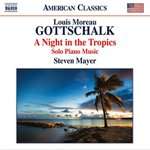|
Back
08/07/2015
Louis Moreau Gottschalk: Le Banjo, Opus 15 – The Last Hope, Opus 16 – Pasquinade, Opus 59 – Berceuse, Opus 57 – Grande fantaisie triomphale sur l’hymne national brésilien, Opus 69 – Le Songe d’une nuit d’été, Opus 9 – Fantôme de bonheur – Reflets du passé, Opus 28 – La Nuit des tropiques: Andante (arr. Steven Mayer)
Steven Mayer (Piano)
Recording: American Academy of Arts and Letters, New York City, New York (April 14-16, 2014) – 64’ 57
Naxos # 8.559693 – Booklet in English

   
Louis Moreau Gottschalk’s life of only 40 years is nothing short of extraordinary. Born in New Orleans, his childhood musical training occurred in Paris at age 14. Flush were his colorful compositions featuring an amalgam of Caribbean/Latin American/African rhythms, Ragtime, circus gyrations, Steven Foster stanzas and Civil War memorabilia. People flocked to hear his wide range of sassiness and percolation on three continents. The famous mid-Nineteenth century composer was greatly influenced by Franz Liszt, Sigismond Thalberg, and, most notably, Frédéric Chopin.
Gottschalk notes are intimidating to anyone; therefore, credit goes to those who have accomplished the “near-impossible.” But beyond that level is an attempt to discover a pianist’s discerning outreaches. Generally, Steven Mayer’s approach to this music is more “academic” and “conservative.” Notwithstanding difficulties of several scores, there’s a missing sense of spontaneity and ebullience amongst more colorful canvases.
Likely an expected attention-getter, Mayer’s opening Le Banjo, possesses an overall languid tempo in comparison to more bubbly, aggressive approaches by Cecile Licad. The same holds true in gavotte-like stances within the ever-popular Pasquinade. Mr. Mayer pauses with deliberation, and the upper runs are virtually pristine though he uses time to his intentional advantage.
Where Steven Mayer draws his best strengths is inside a more subdued Gottschalk. Mr. Mayer has an incredible touch of delicacy using right-hand articulation inside the solemnly celestial reaches of The Last Hope. The pensive accents are well translated. Gottschalk’s own Berceuse breathes pervasive Chopin touches but with lighter ornamentation. A friend to Ambroise Thomas, it comes as no surprise to find that the Gottschalk midpoint melody line reveals the musical stretch, “Plus de soucis”, from Mignon. Here, Mayer rests comfortably and peacefully.
Mayer evinces grand Chopin élan within Gottschalk’s Grande Fantaisie: he finds security in slower approaches. Though the composition’s mid-section has attenuations of jaunty pronouncements (thematic variations), Mayer has found his zone within this work. Gottschalk also derived an extract based on an aria found inside Thomas’ Le Songe d’une nuit d’été (1850). There is a légèreté soufflé inside Mr. Mayer’s interpretation that capitalizes on Puckish delight and sense of fairy-fantasy orb. It is one of Steven Mayer’s finest moments.
A well-established ennui surrounds the Fantôme de bonheur with its own vein of Chopin. Impressions of falling light rain are conveyed nicely. Similarly, the sobering attitude of Reflets du passé reveals a delicate Mayer with exploration of human emotional pining and longing.
We hear a World Première Recording with Mayer’s reconstruction of La Nuit des tropiques. Artur Napoleau, a Gottschalk contemporary, originally expurgated a swath of music. In this arrangement, the Mayer reassembly is thoughtfully tailored back into the work using healthy provisions while utilizing a “three handed effect” to elicit broad orchestration. The result is quite convincing.
Christie Grimstad
|